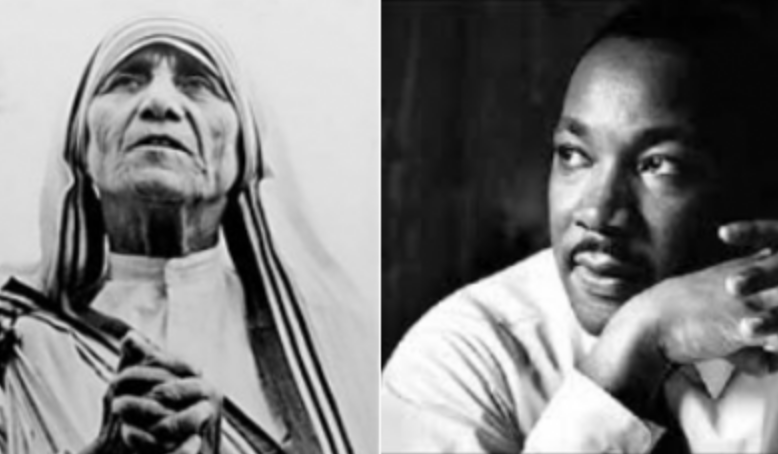What do these simple words mean?
Mother Teresa, the sainted Catholic nun of the last century, learned from the experiences in her life. That is how she discovered her answer to this question as humility.
Through countless experiences with those who were alone and forgotten, in need of care, she found her own humanity. She lived a ‘Life Worth Examining.’
After Mother Teresa’s death in 1997, a reporter told the story of how he went to Calcutta in hopes of interviewing this amazing woman. He wanted to know who she was, and why she did what she did?
Upon arriving, he very quickly learned his answers in ways he never anticipated. Rather than stop what she was doing to have a mannerly chat, Mother Teresa thrust a babe into the reporter’s arms telling him that if he were going to talk with her, he would be coming with her. And he would be helping!
The reporter’s life view changed. So did mine.
His learning seemed to be about love.
Mine was about compassion.
Hearing his story, I realized how I was boundaried by the habit of social custom. Early politeness training. I was caught up in propriety that made me stop whatever I was doing in deference to people like this reporter. All under the beguiling guise of human kindness.
Reading his story brought pictures from my own life to mind….
How many times had I burned a meal? When I just left it because someone needed something, ‘right now!’
Forgotten a phone call?
Kept others waiting?
Because I couldn’t bring myself to say ‘no,’
or ‘wait,’
or ‘later’?
Mother Teresa helped me realize the unkindness I allowed when distracted from the work of aiding those in need. She helped me understand that what I had judged as rude, was wrong-thinking. She gave me a living example of how to reTHINK my FEELing. Her example helped me suspend my beliefs just long enough to convert resistance into a flow.

HOW?
The messages in Mother Teresa’s action helped me transcend my idea that “No” is rejection, a shutting out of another. A cause for separation, and the root of denial. Permit me to explain how.
As a journalist, I could see the reporter’s point of view. He was just doing his job, getting the secular scoop.
As an interfaith minister, I could see the nun’s point of view. She was just ministering, performing her sacred duty.
As a dream interpreter, the two could co-exist peacefully. Through him the material met the spiritual. Through her the spiritual materialized. Mutual arising. The consciousness of both was elevated toward a common good.
Now, for the rest of the story…
One day, while telling this story to a group of student-teachers, something unexpectedly happened. In viewing the scene in my mind’s eye, I saw a truer beauty in the impact of Mother Teresa’s choice than I had previously noted.
From the reporter’s view, it seemed Mother Teresa was saying, “No, I’m not going to sit down and talk with you.”
From the nun’s view, she was saying, ‘Yes, if you want your answers, you’ll need to do more than observe and ask. You will need to do the work yourself.’
The interaction that happened between the two BECAUSE THE REPORTER ALSO SAID YES is what struck me that day.
The nun had never denied the reporter at all. She was merely true to her own message and open to his participation in it. She offered him an experience worthy of the writing.
What a dreamer Mother Teresa was! Like her contemporary, Martin Luther King, Jr., half a world away. He shared her passion for not allowing our conscience to sleep.
I began to realize that enlightenment might be something very different than I had been dreaming up in the daylight hours.
Enlightenment might be a process as well as an accomplishment. A journey as well as a destination.
I have examined my life differently ever since I shared this story. I am grateful.
In the early 1970s while at university, I took an ethics course. It became one of the many points in my life that I have sought to connect to deepen Self awareness. One of the assigned books was Plato’s Apology. It is the story of how his teacher, Socrates, concluded his life. You have probably heard the famous quotation that sums up the wisdom born from a lifetime of concentration: “the unexamined life is not worth living.”
The fragment stuck with me because, even in my 20s, I wanted to examine life. I chose journalism as my academic focus because I wanted to be able to tell other people’s stories. To embrace their lives as worth examining, and share it with everyone. It seems that passion, for exalting the uniqueness in each individual, their contribution to a greater whole, continues to beat in my heart decades later.
Centuries after Socrates lived, an American scholar Joseph Campbell made his life’s work the exploration of the stories we tell ourselves in cultures. He called these public myths. He opened his mind, and looking, he saw the similarities coexisting in the differences.
“People say that what we’re all seeking is a meaning for life,” Campbell says in the Power of Myth. “I don’t think that’s what we’re really seeking.
“I think that what we’re seeking is an experience of being alive, so that our life experiences on the purely physical plane will have resonances with our own innermost being and reality, so that we actually feel the rapture of being alive.”
I believe Mother Teresa experienced rapture.
I believe that through her mindful actions that reporter did as well.
I know through uniting what they represent to me, a deep wisdom continues to grow within me.
This is the power of story. This is why I know I will write about Lives Worth Examining for the rest of mine. ∞

Recent Comments